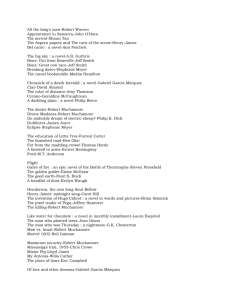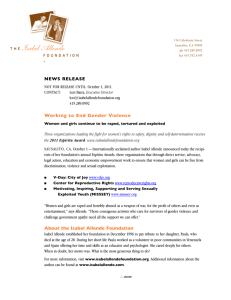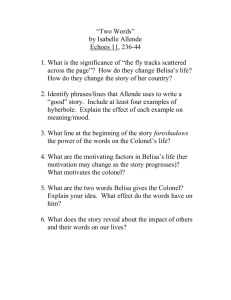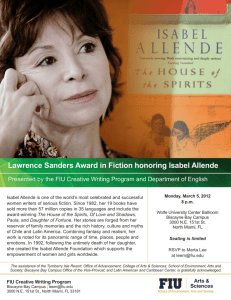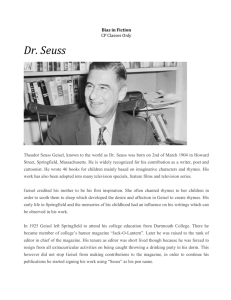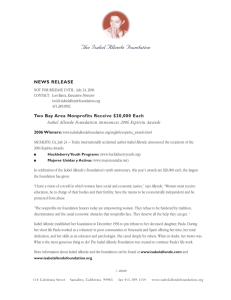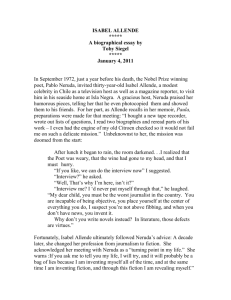English
advertisement
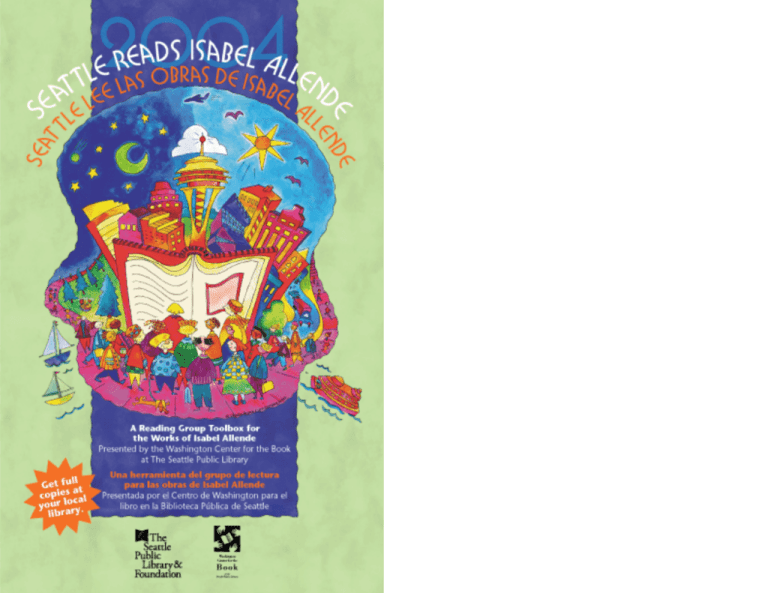
Introduction to Isabel Allende: A Brief Biography Isabel Allende was born in 1942 in Lima, Peru. She moved to the Chile fictionalized in her novels when her parents divorced three years later. The small family – Doña Panchita, Isabel, and her two brothers – moved in with Isabel’s maternal grandfather in Santiago. Although her father severed contact with his wife and children, Allende remained close to her father’s family, including her second cousin and godfather, Salvador Allende Gossens, whom she called “uncle.” It was in Santiago that Allende began to soak up the stories of her ancestors, stories that would serve to form the basis of her first novel, The House of the Spirits. In the introduction to My Invented Country, Allende writes: “I have been an outsider nearly all my life… . I have been a pilgrim along more roads than I care to remember” (p. xi). This sense of foreignness was exacerbated when her father, a diplomat with the Chilean government, was appointed first to Bolivia, then Beirut. In both places, Allende attended private English-speaking schools, an experience that made her even more aware of her status as an outsider. The Suez Canal crisis in 1958 led to Allende’s return to Santiago, where she finished her studies and met Miguel Frías, her first husband. Married in 1962, Allende and Frías had their first child, daughter Paula, then lived in Europe for two years, returning to Chile where their son, Nicolás, was born in 1966. During this period, Allende also worked for the United Nations in Santiago, becoming a press officer in the department of information. This work and her time in Europe awakened Allende to the disadvantages of being a woman in a patriarchal Chilean society. Allende’s journalistic career became more political in 1967, when she began writing for the feminist women’s magazine, Paula. She continued writing a humorous column and feature articles for the journal for the next seven years, while also contributing to a children’s magazine and anchoring two popular programs on Santiago television. According to Allende, “For the first time in my life, I belonged.” (My Invented Country, p. 132.) The September 11, 1973, coup led against Allende’s godfather, President Salvador Allende, marked the end of Allende’s “belonging.” As the Pinochet regime continued to tighten its grip on the politics and References to page numbers throughout this English toolbox refer to the English editions of the book. news of Chile, Allende increasingly found herself in a precarious situation. Finally, in 1975, she fled with her family to Venezuela, where they would live for 13 years. Once again, Allende was an outsider. Early in 1981, Allende received word that her 99-year-old grandfather was dying. On January 8, Allende started writing her first novel. The House of the Spirits began as a letter to her grandfather, a letter composed of the stories he had shared with her about their family when she was a child. “[The House of the Spirits] was … triggered … by nostalgia, by the desire to recover the world that I had lost after I had to leave my country and live in exile,” Allende explains. That sense of yearning and nostalgia has continued to imbue Allende’s novels. Her melding of history and imagination makes her the leading female writer of magic realism, a Latin American literary style where fantasy and reality co-exist. The success of The House of the Spirits allowed Allende to leave her position at a secondary school in Caracas and begin writing novels full time. Her next novel, Of Love and Shadows, was fueled by the author’s anger at the terrible events in Chile: the love story is set against the backdrop of the Pinochet dictatorship’s atrocities. With Eva Luna and The Stories of Eva Luna, Allende’s writing continued to be tied to her emotions – about herself, her Chile, and her new home, Venezuela. Allende was divorced in 1987. That same year she met the man who would spark the next stage of her pilgrim’s journey. Allende married William Gordon, a Sausalito lawyer, and his story became the core of her next novel, The Infinite Plan. Published originally in Spanish in 1991 (in English, in 1993), The Infinite Plan is Allende’s first book to feature a world outside of her created Chile. The book alternates between third and first person to relate the story of late 20th century America through the life of an itinerant cult leader’s son. Enjoying her new life in the United States, Allende once again began the slow process of starting to “belong,” only to have her life shattered in 1991 when her daughter, Paula, fell into a year-long coma, and died. The resulting memoir, Paula (1995), begins with the memorable first line: “Listen, Paula. I’m going to tell you a story, so that when you wake up you will not feel so lost.” Mostly comprised of her letters to her unconscious daughter, Paula is the closest that Allende has come to writing an autobiography. In it, she shares the family stories that have inspired her novels. Allende waited three years before publishing Aphrodite, a recipe and essay collection that focused on aphrodisiacs, in 1998. Daughter of Fortune, a novel about the Chilean experience in the California Gold Rush, followed. Daughter of Fortune features many of the trademarks of an Allende novel, illustrating the author’s love of both her new country and her Chilean past. This novel was followed by Portrait in Sepia, detailing the life of the granddaughter of the heroine of Daughter. During most of her exile Allende had always thought she would return to Chile. However, by the time Pinochet was removed from power, Allende had married her American husband, and her son and his family had followed her to a new life in California. Although still considering herself a Chilean, her roots had begun to be replanted in California. Then, on the 28th anniversary of the military coup in Chile, terrorists attacked the Pentagon and the World Trade Center. According to Allende, that was when “I gained a country.” (My Invented Country, p. xii.) Since that crisis, Allende published two more books, a young adult fantasy entitled City of the Beasts (2002), and My Invented Country: A Nostalgic Journey Through Chile (2003). Partially inspired by her love for her grandchildren, both titles focus on themes of family, self-discovery, and home. My Invented Country 1. What is the meaning of the title, “My Invented Country”? 2. What initial impressions of Chile does one get from the opening scenes? How does landscape correspond to its inhabitants? In what ways does Allende’s persona reflect this geography? 3. In the introduction, Allende writes, “Minotaurs lie in wait in the labyrinth of memory.” What might she mean? Does she confront a minotaur? 4. What is the author trying to accomplish? Does she succeed? Why or why not? 5. The book’s title reminds us of the subjectivity of memory. Allende herself often says that she cannot tell the truth (i.e., only the facts) of her history. What is the truth of My Invented Country? 6. Allende spent many years of her life before exile abroad. How did this influence her as a fiction writer? How did it influence her as a Chilean woman? 7. Allende powerfully recalls the aftermath of the September 11 military coup that launched Pinochet’s reign of terror in 1973. She describes the fallout in personal terms: families torn apart by informants, a nation’s faith in its electorate shaken, a vibrant cultural climate replaced by one of suppression. What are the parallels and differences between the trauma of Chile’s 9/11 events and those that occurred in the United States 28 years later? 8. Allende writes that Chilean status was not heavily tied to wealth before the Pinochet years, but in contemporary Chile the ruling class is extremely affluent – possibly at the expense of a oncesizeable middle class. Is this situation uniquely Chilean, or were the 1970s and 1980s were marked by similar economic shifts around the world? 9. What does the book reveal about Chilean attitudes about sexism, racism, and political correctness? How might the book be different if the author had been male or mestizo? What is Allende’s attitude towards her homeland? 10. Allende’s fiction often features characters who have unusual perceptions of reality, or are able to tap into spiritual worlds as easily as tangible ones. Does My Invented Country evoke any of these themes? In what way does it complete the memories recorded in her memoir, Paula? 11. How, if at all, does this book fit into the magic realism literary tradition, as seen in Allende’s novels such as The House of the Spirits? City of the Beasts 1. How does Alexander’s nightmare at the beginning of the story, about the horrible black bird carrying his mother away, set the tone for the entire book? What do birds represent in the story? What hints does Allende give the reader about them prior to Alex’s understanding of his dreams and visions of birds? 2. Alex’s father tells him that the Chinese character for “crisis” means both “danger” and “opportunity” (p. 14). How does the story illustrate this concept? 3. Professor Leblanc’s arrogant and pompous personality provides comic relief for both the reader and the characters in the story. People don’t take him seriously until the end of the book when it is his quick thinking that saves the group from Captain Ariosto. At the start of the expedition, he asserts that brutality is a natural state and that “compassion is a modern invention” of humans (p. 55). What does he learn that changes his opinion? 4. 5. How would you describe the Beasts? Is “beast” an appropriate term for them? Who are the real beasts in the story? (See p. 108.) Does Kate love her grandson? Why does she force him to learn everything the hard way – by experience? What was she trying to teach Alex by bringing him along on such a dangerous trip? Should she have taken better care of him by telling him what to expect and being nicer to him? What does she learn? 6. Adventure stories often involve two kids, a kid with a parent, or a kid alone. Why does the author send a boy with his grandmother on this adventure? How is Kate like Walimai? 7. Why does Alex’s quest involve crawling in a cave to find the Fountain of Youth? Why does Nadia have to scale the mountain to find the crystal eggs? To whom did they give their gifts of the amulet and the flute? 8. What is the author’s message concerning the kinds of gods people have? Why did the Indians of Tapirawa-teri think of the Beasts as gods? It is suggested that the gods would probably think of the Indians as their gods. What kinds of gods have people made for themselves through the ages? 9. How do you explain supernatural things like the shaman’s “wifespirit” or the Indians’ ability to become invisible? Did Alex really communicate with the jaguar? Was Nadia really invisible? Or was it all in their heads? 10. Why is it important to save the last vestiges of ancient civilizations, such as the People of the Mist? What are the pros and cons of preserving the untouched lands of the Amazon and other natural resources on earth at the expense of a country’s economic development? 11. What would be an appropriate punishment for Mauro Carias and Dr. Omayra Torres, after their wicked plot is exposed? What made Torres willing to follow Carias’s evil plan? 12. Padre Valdomero refused to try and convert the Indians to Christianity, saying they had their own spirituality. What was the padre’s actual role in the village? 13. What are some of the lessons Jaguar and the Eagle girl learn on this adventure? What is the author trying to tell the reader? Is this book more than an adventure tale? Paula 1. What is this book about and for whom is it written? How does the reader’s knowledge of Paula enhance the story? 2. Does Paula have a foreshadowing of her death as exemplified by her purity, her altruism, and her attempt, as her mother writes, “to be one with God.” Can anyone really foretell her or his own death? Does Allende mythologize her daughter? Could Paula be as good as her mother believes? 3. In what ways is Paula’s story similar to a Greek tragedy? Does it achieve mythic standards? 4. How does an understanding of poryphyria, Paula’s disease, enhance one’s reading of the book? 5. How is Allende’s life changed by Paula’s death? What purpose does this book serve for the author? The reader? 6. Why does the book take the form of a letter? Why are there no chapters? 7. Allende writes the book as if she doesn’t know the ending. How does this affect the reader? 8. How did the author’s method of moving from the past to the present affect your reading of the book? What makes this style work for Allende? 9. What helps Allende move beyond her loss? In an interview, Allende has been quoted as saying, “writing is my way of mourning.” 10. If this book were truly written for personal reasons, why was it published? 11. What does Allende reveal about herself that she may not have intended to? 12. How do the family stories contribute to our understanding of Paula and/or Allende? 13. Why does it often take a catastrophe such as illness or death to enable individuals to become more forthcoming? 1. The Infinite Plan 8. Why did the author choose The Infinite Plan as the title of this book? What, if any, links exist between the protagonist’s life and his father’s religious creed? At the end of his life it is obvious that Charles Reeves was a very sick man. What was wrong with him? How does this illness symbolize his inner struggle? 9. Discuss the implications of the narrative shift that occurs throughout the novel, between third person and first person. Notice the points at which the omniscient narrator’s voice changes to the first person voice of Gregory: see p. 23, 82, 101, 125, 173, 219, 253. Why does the author choose to tell these sections in Gregory’s voice? To whom is he telling his story? Who is the omniscient narrator? 2. This is the first Allende novel to have an American setting and characters. Allende wrote it in Spanish after she moved to California. How does the story reflect both the Latin and American aspects of its author? 3. Greg says (p. 23) that his mother Nora gave him three major gifts: “love for music, tolerance, and a sense of honor.” What else was she responsible for in his life? Why was she so withdrawn? (Hint: p. 29.) What made her incapable of letting go of her husband after his death? 4. 5. 6. 7. What was Olga’s role in Gregory’s family? Does she actually help him by having sex with him during his adolescence? (See p. 93 and following.) Charles Reeves’ “Infinite Plan” is explained in his own words (p. 27-28). Did he actually believe what he preached? How did his life as a traveling preacher alter his view of reality and that of his family? Why does Gregory later think of childhood as the only happy time in his life? What is Gregory looking for in this story? (See p. 84, 86, 177.) What does he believe in by the story’s conclusion, when he finds the old “Infinite Plan” sign from his father’s caravan? (p. 379.) Desertion is a big theme in this book: emotional withdrawal, like Nora and Samantha; and physical desertion, like Charles Reeves’ death and the way Gregory treats Carmen. How does fear of desertion or separation shape the story? How does Gregory compensate? How does he learn to trust again? (p. 244.) What happens to his children? 10. Gregory tells us (p. 172), “I did not feel at home anywhere; the barrio where I had grown up belonged to the past, and I had never put down roots anywhere else.” Why are roots important? Why wasn’t Gregory able to identify with any culture or community? What is Allende telling readers about personal and ethnic identity? 11. In the section about Gregory’s experiences as a soldier in Vietnam and the shock of his return home, Timothy Duane says that people at home were less shocked about the American dead than embarrassed about not winning the war. How did his experiences in Vietnam change Gregory? 12. Gregory ends up saving the wounded in Vietnam under nearly impossible conditions. Why did he do it? Who was he metaphorically saving? 13. Why did the author keep Carmen and Gregory from falling in love? What was Carmen’s role in the story? How did she change? Why don’t readers get more of her inner thoughts, the way we do Gregory’s? 14. Why was Gregory unable to connect with his wives and children? Why was he attracted to these women and how did his children become so psychologically damaged? 15. Why couldn’t Gregory be satisfied with the “American dream” of making lots of money and surrounding himself with beautiful women? 16. Think about the author’s portrait of America during the decades between 1950 and 1980, seen through the eyes of Gregory. What makes his perspective unique? How was Gregory influenced by his itinerant life as a child, his parents’ pseudo-spiritual religions, and life in the barrio? 17. What does Allende want readers to take from this book? The Stories of Eva Luna 1. Discuss the common thread that ties these stories together. How does the last story tie in with the prologue of the book? 2. Why does the author so often put women and men in opposition to each other? Nearly all the women in the stories are abused or manipulated by men. Why do the villagers take men’s abuse of women in stride? (See especially “If You Touched My Heart.”) 3. 4. Why does Eva Luna tell these stories, and why to Rolf? Is Isabel Allende Eva Luna? How does Allende remind the reader throughout the book that Eva and Rolf are part of the stories? Think about the lush imagery in the stories: the lichens that grow on Hortensia’s body in her captivity (p. 86); the mangoes that people throw at a murderer’s house that rot it from within (p. 215); the mud that buries the little girl, Azucena, in the final story, “And of Clay Are We Created.” What moods does the author create, and what messages do these images send? 5. What is the purpose of using “magical realism” to illustrate a point in Latin American literature? How does Allende compare to other authors who use the same technique? How would these stories be different if they didn’t include these magical elements? 6. How are these stories connected to Allende’s novel, Eva Luna? How might reading Eva Luna enhance your understanding of this book? 7. On the author’s web site in her Questions-and-Answers section, Allende says, “I do believe in destiny. I believe that we are dealt a hand of cards and we have to play the game of life as best we can. And often the cards are marked.” How is this philosophy reflected in her stories? 8. How does storytelling “create” reality? Why is describing an actual event or person so difficult? If over time an event is immortalized through story, does the storyteller’s embellishments make the tale itself less “true“? How do a storyteller’s words form our perceptions? 9. In “Two Words,” Belisa Crepusculario makes her living selling words. What aspects of her location, culture, and personality make this possible? How would Belisa do if she were to materialize in Seattle 2004? Why? 10. In many of these stories, the women seem to be mistreated or disrespected in the beginning but emerge strong as perspective shifts. Discuss examples of this and how Allende’s writing draws the reader into the characters to make us care that these women often come out on top. 11. In “Revenge,” the only daughter of a murdered Senator vows to avenge his death. Was she successful? Why or why not? Eva Luna 1. The power of language is a central theme in Eva Luna. Eva Luna says that the gift of storytelling was passed along to her from her mother Consuelo, who “supplanted with poetic flourishes what she lacked in information.” What does Eva learn from her mother and from the art of storytelling itself? What does Eva’s storytelling provide the lives of others? 2. Eva means “life” and Luna means “moon.” How does Eva exemplify her name? 3. Eva loses her mother when she is still very young. How does this loss affect her life? Where else does she find maternal support? What do you think of the periodic appearance of her mother’s ghost? Are we to take these visits literally? 4. How does Allende suggest that women survive in a “man’s world”? How are gender and sexuality explored in the novel? 5. Rolf Carle and Huberto Naranjo are very different men who play important roles in Eva’s and each other’s lives. How do their worldviews differ or intersect? How do they change or enhance Eva’s life? 6. What roles do fate and talent play in Eva’s life and story? Are they at odds? Does Allende believe in fate? Do her characters? 7. Porcelain, or Universal Matter, has the ability to copy and create replicas of real things, or as Eva says create “a world of lies.” What does Universal Matter represent? How does the metaphor enhance the story? 8. What relationship exists, in Allende’s opinion, between reality and storytelling? How do stories work with or create reality? 9. Why does Eva tell stories? Is Eva Luna Isabel Allende? 10. Once Eva and Rolf find each other, Eva tells a sweeping story about the future of their love but counters it with: “Or maybe that isn’t how it happened.” What does she suggest about the nature of story and of love? 11. Allende’s writing is colorful, imaginative, and intoxicating and has often been described as having elements of “magical realism,” or the fantastical. How did the style of the writing affect you as a reader? How would you describe Allende’s writing style to a friend? The House of the Spirits 1. In what ways is Clara not a typical child? 2. Discuss the relationship between Rosa and Esteban Trueba. How did Rosa’s death change Esteban? What did you think of his marrying her sister? Did Esteban ever recover from Rosa’s death? 3. What is the “craziness” that affects the Trueba women? Why are they this way? 4. Are Clara’s powers real? Are the spirits real? Who are they? 5. Discuss the role of Jean de Satigny. Why was he brought into the story? What did you think of his disappearance from the story (the home he set up with Blanca and the secrets he kept from her)? Was it a good idea for Blanca to tell Alba he was her father? 6. What was the essence of the relationship between Clara and Ferula? Why was Esteban so jealous? What were the effects of Ferula’s curse? 7. Discuss the various rises and fallings in this story (tres marias, politics, the magnificent house, tradition). How would you describe the theme of the novel? 8. Jamie and Nicolas are not close with each other, nor with their father. What keeps them from relating to one another? Do you think the women in this story relate to each other better than the men? 9. What was the role of the Mora sisters? What effect did they have on the children Clara raised? 10. Given the book’s autobiographical nature, why would Allende use fiction to portray her family’s story?
